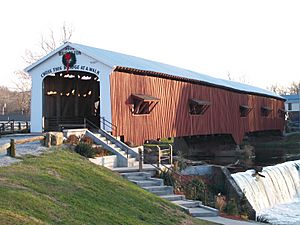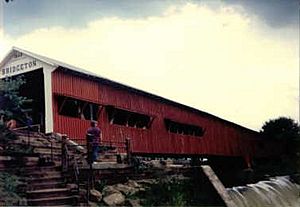Bridgeton Covered Bridge facts for kids
Quick facts for kids Bridgeton Covered Bridge |
|
|---|---|

Rebuilt Bridgeton Covered Bridge (2006-Present)
|
|
| Coordinates | 39°38′57.82″N 87°10′34.43″W / 39.6493944°N 87.1762306°W |
| Carries | Pedestrian traffic |
| Crosses | Big Raccoon Creek |
| Locale | Bridgeton, Indiana |
| Official name | Bridgeton Bridge |
| Named for | Bridgeton, Indiana |
| Characteristics | |
| Design | Burr arch truss bridge |
| Material | Sandstone block (foundations) |
| Trough construction | Wood |
| Pier construction | Unknown |
| Total length | 267 ft (81.4 m) (includes 11 ft (3.4 m) overhangs on each end) |
| Width | 13 ft (4.0 m) |
| Longest span | 122.5 ft (37.3 m) |
| Number of spans | 2 |
| Piers in water | 1 |
| Clearance above | 12 ft (3.7 m) |
| History | |
| Constructed by | Dan Collom & local community |
| Construction cost | $125,000 |
| Opened | October 1, 2006 |
| Bridgeton Covered Bridge | |
|---|---|

Old bridge
|
|
| Carries | Bridgeton Road Bridge bypassed in 1967 |
| Crosses | Big Raccoon Creek |
| Locale | Bridgeton, Indiana |
| Official name | Bridgeton Bridge |
| Named for | Bridgeton, Indiana |
| WGCB # | 14-61-04 |
| Characteristics | |
| Design | Burr arch truss bridge |
| Material | Sandstone block (foundations) |
| Trough construction | Wood |
| Pier construction | Unknown |
| Total length | 267 ft (81.4 m) (includes 11 ft (3.4 m) overhangs on each end) |
| Width | 13 ft (4.0 m) |
| Longest span | 122.5 ft (37.3 m) |
| Number of spans | 2 |
| Piers in water | 1 |
| Clearance above | 12 ft (3.7 m) |
| History | |
| Construction cost | $10,200 |
|
Bridgeton Covered Bridge (#8)
|
|
|
U.S. Historic district
Contributing property |
|
| Lua error in Module:Location_map at line 420: attempt to index field 'wikibase' (a nil value). | |
| Built | 1868 |
| Built by | J. J. Daniels |
| Demolished | April 28, 2005 (Arson) |
| Part of | Parke County Covered Bridges TR (ID64000193) |
| NRHP reference No. | 78000386 |
| Added to NRHP | December 22, 1978 |
The Bridgeton Covered Bridge is a famous landmark in Bridgeton, Indiana. The first bridge was built in 1868. It was a special type called a Burr Arch bridge. This bridge was closed to cars in 1967. Sadly, it was destroyed by fire in 2005. But don't worry, a new bridge, looking just like the old one, was built in 2006. It's now a popular spot for people to visit.
Contents
The First Bridgeton Bridge
The area around Bridgeton, Indiana, has a long history with mills and bridges. Around 1823, the first mill was built on Big Raccoon Creek. This mill changed owners many times over the years. It was rebuilt in 1871 after a fire. The town itself was named Bridgeton because of its early bridges.
Early Bridges and Their Challenges
Before the famous covered bridge, two open wooden bridges stood in its place. Both of these earlier bridges had problems. One time, a family and their wagon fell into the mill pond when the first bridge collapsed! Luckily, they were rescued. A second bridge was built, but it also fell down. Because of these issues, a stronger, covered bridge was needed.
Building the Covered Bridge
In 1868, the decision was made to build a new, more reliable bridge. Several builders offered different plans. The contract was given to J. J. Daniels, a well-known bridge builder. He used a "Burr Plan" design, which is known for its strong arch structure. The bridge cost $10,200 to build. It was placed right above the mill dam, with its foundations connected to the dam.
The bridge was very important for the town. It served as a main crossing for many years. In 1967, the bridge was closed to car traffic. After that, benches and steps were added, making it a nice place for people to walk and relax.
The Bridge's Sad End
On April 28, 2005, the historic Bridgeton Covered Bridge was sadly destroyed by arson. This was a big loss for the community.
The New Bridgeton Bridge
After the old bridge was destroyed, the people of Bridgeton and the state of Indiana worked together. They decided to build a new bridge that looked just like the original. This new Bridgeton Covered Bridge was completed in 2006. It now serves as a pedestrian bridge, meaning only people walking can cross it. It continues to be a symbol of the town and a popular attraction.
Images for kids


